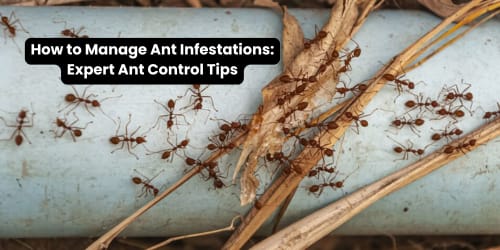
Maybe the most unhygienic household nuisance is an ant infestation. These stealthy invaders can quietly sneak into your kitchen, bathroom, or garden and ransack it, so it’s crucial to know how to control them effectively. This post should help you decipher why they are there and how to deal with them; knowing whether it is sugar ants, carpenter ants, or any other species will help you reclaim your space. Ant control is essential for maintaining a clean and safe home.
Essential Steps for Effective Ant Control
1. Identify Species of Ant
The ant species differ in their behavior and nesting behaviors, so it would help to figure out which type you will deal with. Carpenter ants typically nest in damp woods, damaging the structures, whereas sugar ants are attracted mostly by sweet foods. Knowing the ant species well will enable them to select the best course of treatment.
2. Control Sources of Food and Water
Eliminate food and water to prevent ants. Seal the food in containers, clean countertops, and erase crumbs or spills. Fix leaks to keep water out, as dry conditions deter ants. Proper water management also aids Ant Control and Mosquito Control, preventing breeding. Dispose of waste regularly to avoid attracting pests.
3. Seal Entry Points
Ants can squeeze through the tiniest gaps and cracks in walls, windows, or doors. Check your home for openings, especially around windows, doors, and utility lines. You can seal these holes with caulk or weatherstripping, but this can also keep ants away from your home in the first place.
4. Use Natural Repellents
Most people prefer the use of natural repellents instead of chemicals. Some natural repellents include vinegar, lemon juice, and peppermint or tea tree oil essential oils. For example, wiping surfaces with vinegar can eliminate the ant trails, thereby destroying their means of communication. Essential oils are also efficient repellents; a few drops placed near entry points or areas of heavy activity help deter ants.
5. Install Ant Bait Stations
If these do not suffice, ant bait stations must be utilized. Bait stations have slow-acting poison, which the ants return to the colony to assist in killing off the infestation from its source. Place bait stations near those areas where you’ve noticed the activity of ants but far from pets and children. A baiting system is more effective than sprays since it kills the entire colony rather than a few individual ants.
6. Keep Your Outdoor Environment Clean
If there is any form of food or decaying matter in your outdoors, you invite ants. Clean out fallen fruits from your garden, trim excessive growth of vegetation, and make sure to place your pet food indoors. That way, with a clean outdoor space, you minimize the possibility that ants will find something to enter into your home.
7. Know When to Call a Professional
You should consider contacting a pest control professional for massive infestations or colonies that persist. Experts have specialized tools and treatments for this kind of job, and these will help you solve an ant problem. Professional services are best recommended if you are dealing with carpenter ants because they cause serious damage structurally over time.
Conclusion
Managing ants can only be a combination of prevention, natural means of repulsion, and the occasional targeted treatment. It would be easy to keep those little critters out by eliminating food sources, sealing entry points into the house, and using baits when necessary.
